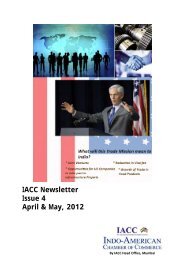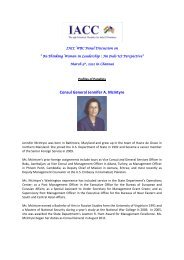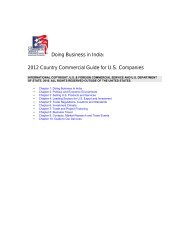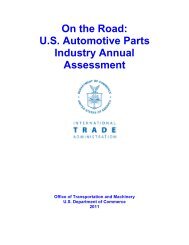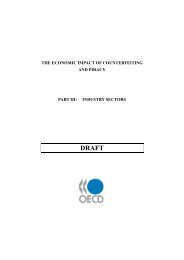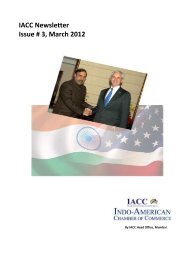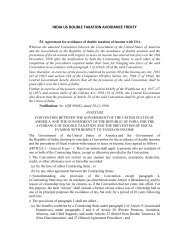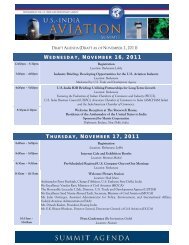Importing into the United States - Indo-American Chamber Of ...
Importing into the United States - Indo-American Chamber Of ...
Importing into the United States - Indo-American Chamber Of ...
Create successful ePaper yourself
Turn your PDF publications into a flip-book with our unique Google optimized e-Paper software.
Tobacco, leaf not stemmed. 59 kilograms (13<br />
lb.) per bale; Sumatra: actual tare for outside<br />
coverings, plus 1.9 kilograms (4 lb.) for <strong>the</strong><br />
inside matting and, if a certificate is attached to<br />
<strong>the</strong> invoice certifying that <strong>the</strong> bales contain<br />
paper wrappings and specifying whe<strong>the</strong>r light<br />
or heavy paper has been used, ei<strong>the</strong>r 113 grams<br />
(4 oz.) or 227 grams (8 oz.) for <strong>the</strong> paper wrapping<br />
according to <strong>the</strong> thickness of paper used.<br />
For o<strong>the</strong>r goods dutiable on <strong>the</strong> net<br />
weight, an actual tare will be determined. An<br />
accurate tare stated on <strong>the</strong> invoice is acceptable<br />
for Customs purposes in certain circumstances.<br />
If <strong>the</strong> importer of record files a timely<br />
application with <strong>the</strong> port director of Customs,<br />
an allowance may be made in any case for<br />
excessive moisture and impurities not usually<br />
found in or upon <strong>the</strong> particular kind of goods.<br />
5. PACKING OF GOODS—<br />
COMMINGLING<br />
PACKING<br />
Information on how to pack goods for <strong>the</strong><br />
purpose of transporting <strong>the</strong>m may be obtained<br />
from shipping manuals, carriers, forwarding<br />
agents, and o<strong>the</strong>r sources. This chapter, <strong>the</strong>refore,<br />
deals with packing goods being exported<br />
in a way which will permit U.S. Customs officers<br />
to examine, weigh, measure, and release<br />
<strong>the</strong>m promptly.<br />
Orderly packing and proper invoicing go<br />
hand in hand. You will speed up <strong>the</strong> clearance<br />
of your goods through Customs if you:<br />
■<br />
■<br />
■<br />
■<br />
Invoice your goods in a systematic<br />
manner.<br />
Show <strong>the</strong> exact quantity of each item of<br />
goods in each box, bale, case, or o<strong>the</strong>r<br />
package.<br />
Put marks and numbers on each package.<br />
Show those marks or numbers on your<br />
invoice opposite <strong>the</strong> itemization of goods<br />
contained in <strong>the</strong> package that bears those<br />
marks and numbers.<br />
When packages contain goods of one kind<br />
only, or when <strong>the</strong> goods are imported in packages<br />
<strong>the</strong> contents and values of which are uniform,<br />
<strong>the</strong> designation of packages for examination<br />
and <strong>the</strong> examination for Customs purposes<br />
are greatly facilitated. If <strong>the</strong> contents and<br />
values differ from package to package, <strong>the</strong> possibility<br />
of delay and confusion is increased.<br />
Sometimes, because of <strong>the</strong> kinds of goods or<br />
because of <strong>the</strong> unsystematic manner in which<br />
<strong>the</strong>y are packed, <strong>the</strong> entire shipment must be<br />
examined.<br />
Pack and invoice your goods in a manner<br />
which makes a speedy examination possible.<br />
Always bear in mind that it may not be possible<br />
to ascertain <strong>the</strong> contents of your packages<br />
without full examination unless your invoice<br />
clearly shows <strong>the</strong> marks and numbers on each<br />
package (whe<strong>the</strong>r box, case, or bale) and specifies<br />
<strong>the</strong> exact quantity of each item of adequately<br />
described goods in each marked and<br />
numbered package.<br />
Also, be aware that Customs examines<br />
cargo for narcotics that may, unbeknownst to<br />
<strong>the</strong> shipper or <strong>the</strong> importer, be hidden inside.<br />
This can be time-consuming and expensive for<br />
both <strong>the</strong> importer and <strong>the</strong> Customs Service.<br />
Narcotics inspections may require completely<br />
stripping a container in order to physically<br />
examine a large portion of <strong>the</strong> cargo. This<br />
labor-intensive handling of cargo, whe<strong>the</strong>r by<br />
Customs, labor organizations, or private individuals,<br />
results in added costs, increased<br />
delays, and possible damage to <strong>the</strong> product.<br />
Importers can expedite this inspection process<br />
by working with Customs to develop packing<br />
standards that will permit effective Customs<br />
examinations with a minimum of delay,<br />
damage, and cost.<br />
A critical aspect in facilitating inspections<br />
is how <strong>the</strong> cargo is loaded. “Palletizing”<br />
cargo—loading it onto pallets or o<strong>the</strong>r consolidated<br />
units—is an effective way to expedite<br />
such examinations. Palletization allows for<br />
16 U.S. CUSTOMS SERVICE



